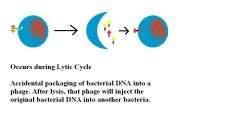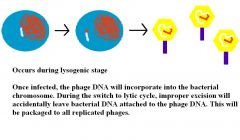![]()
![]()
![]()
Use LEFT and RIGHT arrow keys to navigate between flashcards;
Use UP and DOWN arrow keys to flip the card;
H to show hint;
A reads text to speech;
70 Cards in this Set
- Front
- Back
- 3rd side (hint)
|
What is the control mechanism for the LAC operon? x2
|
NEGATIVE control of INDUCTION
POSITIVE control of INDUCTION |
|
|
|
What is the control mechanism for the Trp operon? x2
|
NEGATIVE control of REPRESSION
Process of ATTENUATION |
|
|
|
Define mutation
|
Heritable changes in the nucleotide sequence
|
|
|
|
T/F - Mutations usually give rise to phenotypic changes.
|
False. They usually don't always give rise to phenotypic changes, but can lead to disease.
|
|
|
|
Define tautomerization
|
An inserted base
will change its base pairing PROPERTIES |
|
|
|
Mutagens increase the rate of what?
|
Mutagenesis
|
|
|
|
Most carcinogens are mutagenic, but......
|
not all mutagens are carcinogens
|
|
|
|
Define silent mutation.
Occurs often where? |
DNA mutation without change in amino acid
often at the 3'position of codon (tRNA wobble) |
|
|
|
Define Missense mutation
|
Base change or substitution alters the type of amino acid
|
MIStake amino acid
|
|
|
Define Nonsense mutation
|
Base change causes sequence changes, such that the chain terminates
|
NOnsense = NO more elongation
|
|
|
Define Frameshift mutation
|
Insertion or deletion of bases (not divisible by 3) that changes the reading frame.
|
|
|
|
Define Null mutation
|
Insertion or deletion of large chunks of DNA.
|
|
|
|
Define Direct DNA repair.
|
Direct enzymatic repair of dimers.
|
|
|
|
Define Excision repair
|
Excision of DNA segment containing damaged DNA followed up by synthesis of new strand
|
|
|
|
Define SOS response
|
Forced induction of many genes after DNA damage, bypassing the errors of DNA
|
|
|
|
Define error-prone repair
|
Last resort before death
|
|
|
|
Transfer of DNA occurs through the form of what Components? x3
|
Plasmid
Chromosome Bacteriophage |
|
|
|
Plasmids:
- what are they - how do they replicate - can they integrate into chromosomes? |
Circular INDEPENDENT pieces of dsDNA
Replicate AUTONOMOUSLY via origin of replication Yes |
|
|
|
What encodes the conjugation apparatus including the sex pili and tra genes?
|
F-plasmid
|
|
|
|
What are the two main groups of plasmids and describe?
|
Large plasmids that are self transmissable
(b/c can form Conjugative Apparatus) Small plasmids that are NON-conjugative (can NOT form conjugative apparatus, but may follow its route) |
|
|
|
What codes for bacterial toxins?
|
Plasmids
|
|
|
|
What codes for Antibiotic resistance?
|
R-plasmids
|
|
|
|
What are the two parts of the R Plasmids?
|
Resistant Transfer Factor (RTF)
R Determinant |
|
|
|
What does the RTF & R Determinant code for?
|
Encodes resistance to antibiotics
|
|
|
|
What forms when the F plasmid integrates into the bacterial chromosome?
|
HFr Strain
|
|
|
|
What happens to R plasmids when selection pressure is lessened?
|
It is unstable to begin with, so it will become lost.
|
|
|
|
T/F - Phages can replicate outside living cells.
|
False, it cannot replicate outside living cells.
|
|
|
|
What does the One Step Growth curve measure? x2
|
Measures
Latency Period & Burst Size of specific virus |
|
|
|
What two cycles are possible when a Bacteriophage infects a cell?
|
Lytic cycle
Lysogenic cycle |
|
|
|
Define prophage
|
A phage genome inserted as part of the DNA chromosome of a bacterium.
|
|
|
|
Define lysogen
|
Bacterium in the state of a lysogenic cycle
|
|
|
|
List the mechanisms for gene transfer. x3
|
Transformation
Transduction Conjugation |
|
|
|
Explain transformation
|
Gene transfer between bacteria by means of "naked" DNA fragments, thus transforming the receiving bacteria's DNA
|
|
|
|
Give a basic definition of Transduction.
|
Transfer of viral, bacterial, or both bacterial and viral DNA from one cell to another VIA Bacteriophage
|
|
|
|
What are the two types of transduction?
|
Generalized
Specialized |
|
|
|
Bacteriophage gene regulation is tightly regulated in what kind of fashion?
|
In a temporal fashion.
|
|
|
|
Generalized Transduction:
- Occurs during which cycle - What happens |

There you go bizzzzaaattttcccchhhh!!!!
|
|
|
|
Specialized Transduction:
- occurs during what cycle - what happens |

My NNNNNNNNNNNNUUUUUUUTTTTTTZZZZ
|
|
|
|
What is the most frequent form of gene transfer?
|
Conjugation
|
|
|
|
Conjugation:
- occurs between? - requires presence of what? x2 |
CAN be between differing bacterial species.
Sex pili & Cell to cell contact |
|
|
|
List two types of Mobile DNA elements in Bacteria
|
1. Bacterial Insertion Sequences (IS)
2. Bacterial Transposons |
|
|
|
Bacterial Insertion Sequences (IS):
- what are they - mechanism of movment |
50-bp inverted repeats flanking regions encoding transposase.
(+/- resolvase) Excision/copying of DNA and its insertion at the target site. |
|
|
|
Bacterial Transposons:
- what are they - mechanism of movement |
Central antibiotic resistance gene flanked by IS elements
Copying of DNA and its insertion at target site |
|
|
|
The Ara Operon utilizes what control mechanism?
|
Positive control of induction
|
|
|
|
Describe the Negative control of induction associated with the Lac Operon.
|
With NO lactose, the operon is OFF
Repressor BOUND (thus neg. control) With ADDED lactose, it binds to repressor, changing its conformation. Thus releasing itself. |
|
|
|
Describe the Positive control of induction associated with the Lac Operon.
|
With ADDED lactose,
cAMP generated cAMP binds with CAP Binds to promoter region, thus enhancing transcription |
|
|
|
Describe the Negative control of Repression associated with the Trp Operon.
|
No Trp means No Repressor bound
With ADDED Trp, it binds to inactive repressor Thus activating repressor which binds operon. |
|
|
|
Describe the process of attenuation associated with the Trp Operon when there is no Trp available
|
Polymerase stalls on sequence 1
Sequence 2 & 3 bind Thus NO Termination Enzymes transcribed |
|
|
|
Describe the process of attenuation associated with the Trp Operon when there is Trp available
|
Ribosome terminates when it encounters the 2 Trp on the leader sequence.
Thus sequence 1 & 2 bind Thus sequence 3 & 4 bind Thus creating Rho independent Termination (hairpin & Loop with Poly U stretch) |
|
|
|
T/F - Plasmids can produce different sex pili.
|
True
|
|
|
|
T/F - Plasmids can not be in the same incompatible group.
|
False.
Plasmids CAN be in the Same Incompatible group |
|
|
|
What can be used for cloning specific DNA fragments?
|
Plasmids
|
|
|
|
Plasmids can code for what? x3
|
1. Bacterial Toxins
2. Enzymes that metabolize unusual substrates 3. Antibiotic resistance (R plasmids) |
TEA
|
|
|
Hfr-strain is formed when what happens?
|
F plasmid integrates into bacterial chromosome
|
|
|
|
Which infected cells are immune from Superinfections from the SAME phage?
|
Lysogenic cells
(with latent phage) |
|
|
|
T/F - The genetic material of a phage is always DNA.
|
False
Can be DNA or RNA |
|
|
|
In generalized transduction, what genes are involved?
what phage is involved? |
Any bacterial gene
(is randomly taken and put into capsid) Lytic phage |
|
|
|
In specialized transduction, what genes are involved?
what phage is involved? |
Restricted Phage genes
(specifically put between bacteria genes: lac & biotin) Lysogenic phage |
|
|
|
Conjugation requires? x2
|
1. Cell to cell contact
2. Sex pili |
|
|
|
F-plasmids encode for what?
|
Conjugation apparatus
includes pili AND tra ("transfer") genes |
|
|
|
T/F - Non-conjugative plasmids exist but can not be transferred along with conjugative plasmids.
|
False
Non-conjugative plasmids CAN be transferred along with conjugative plasmids. |
|
|
|
Transformation can occur (tho rare) but requires what criteria?
|
Bacteria must be in state of COMPETENCE
|
|
|
|
T/F - Transformation works in human cells?
|
True
|
|
|
|
What type of gene transfer requires the presence of a phage?
|
Transduction
|
|
|
|
In conjugation, what initiates the "rolling circle" replication? x2
|
1. Single stranded nick @ OriT
2. Binding of protein @ 5' end |
|
|
|
R-plasmids can be ACQUIRED how?
R-plasmids can be TRANSFERRED how? |
Transposition
Conjugation |
|
|
|
What are the classes of Mutagens? x2
|
CHEMICAL
- Agents that Intercalcate - Base analogs - Chemicals that act like agents of alkylation PHYSICAL - Radiation |
|
|
|
Give an example of a Physical Mutagen and the resulting effects.
|
UV light is a Physical Mutagen
causes Thymine Dimers to form |
|
|
|
Define Recombination (or Post-Replication) Repair.
|
Retrieval of Missing Info
by RECOMBINATION when BOTH strands are damaged |
|
|
|
Recombination (or PostReplication) repair:
- occurs when? - does involve what process - does NOT involve what process - seen in what organism? |
Both strands are damaged
Genetic Recombination DNA Synthesis (b/c template is damaged too) Bacteria (just swapping DNA around) |
|

